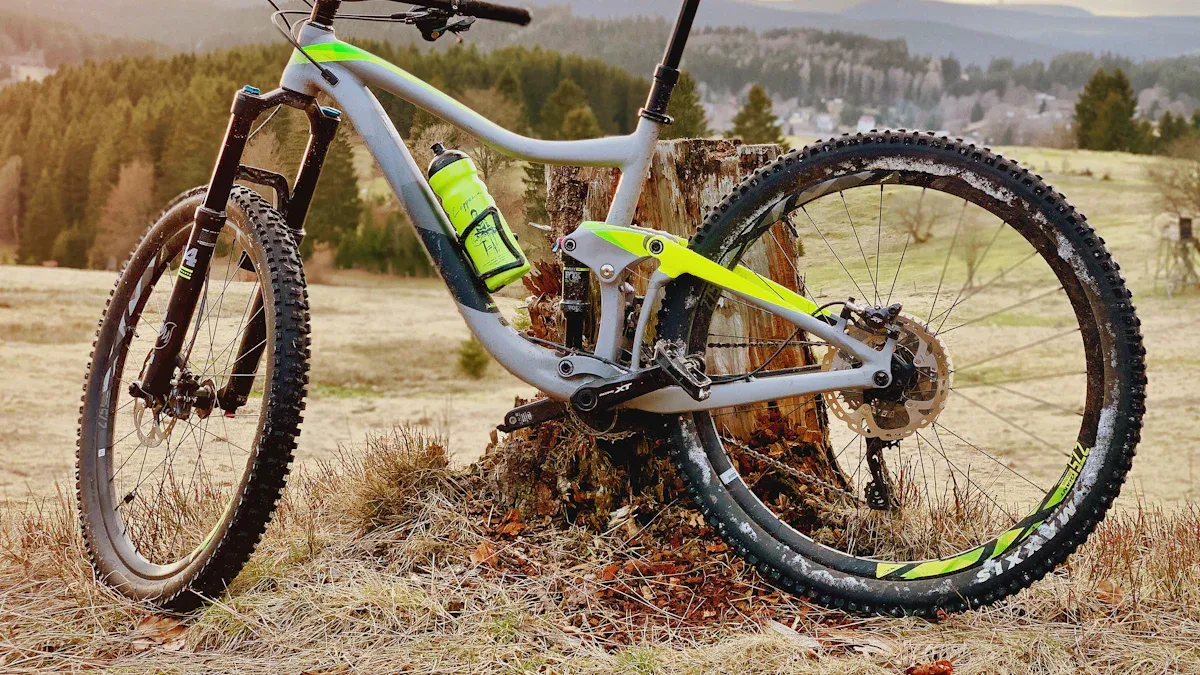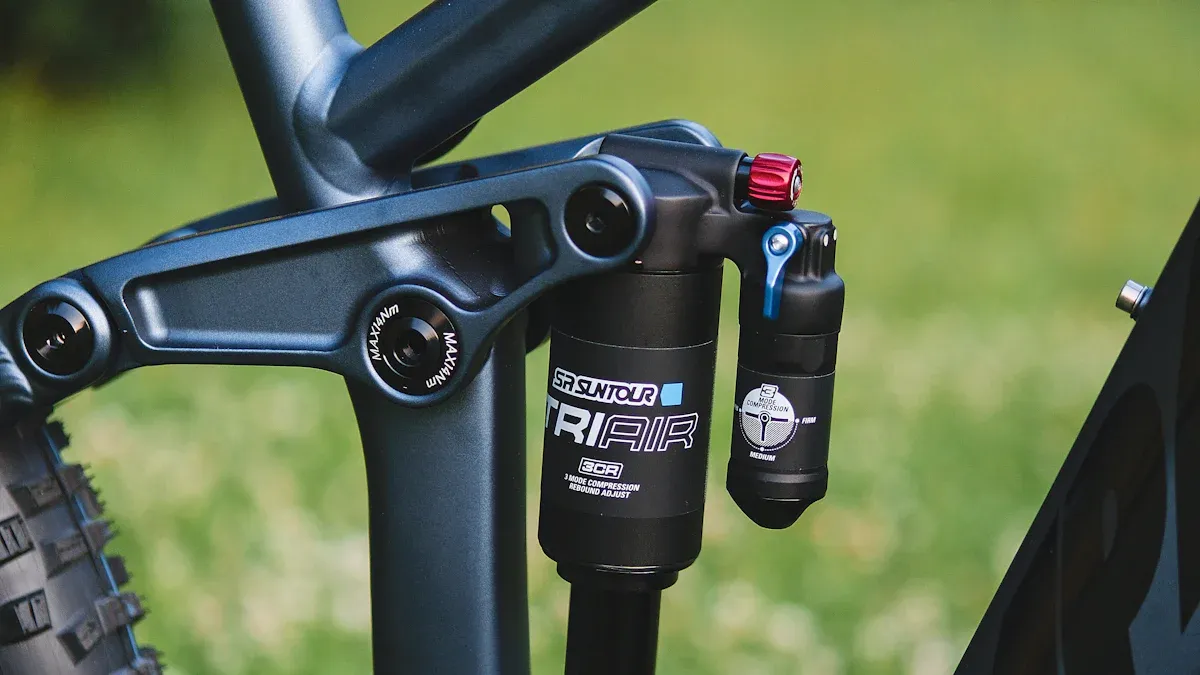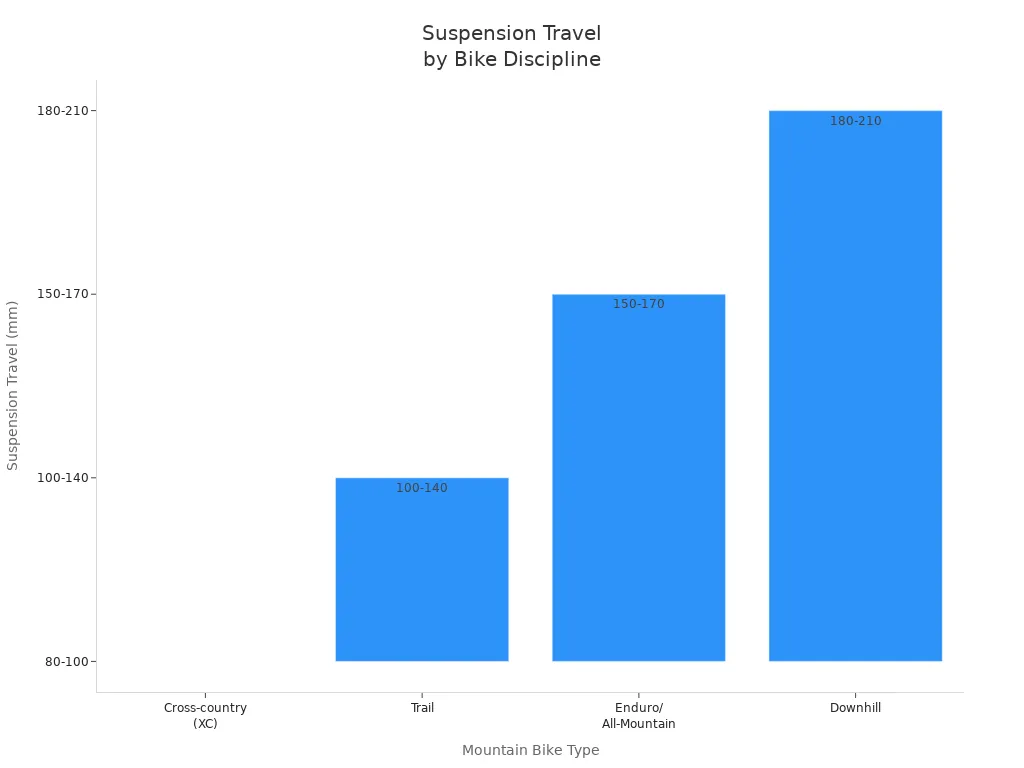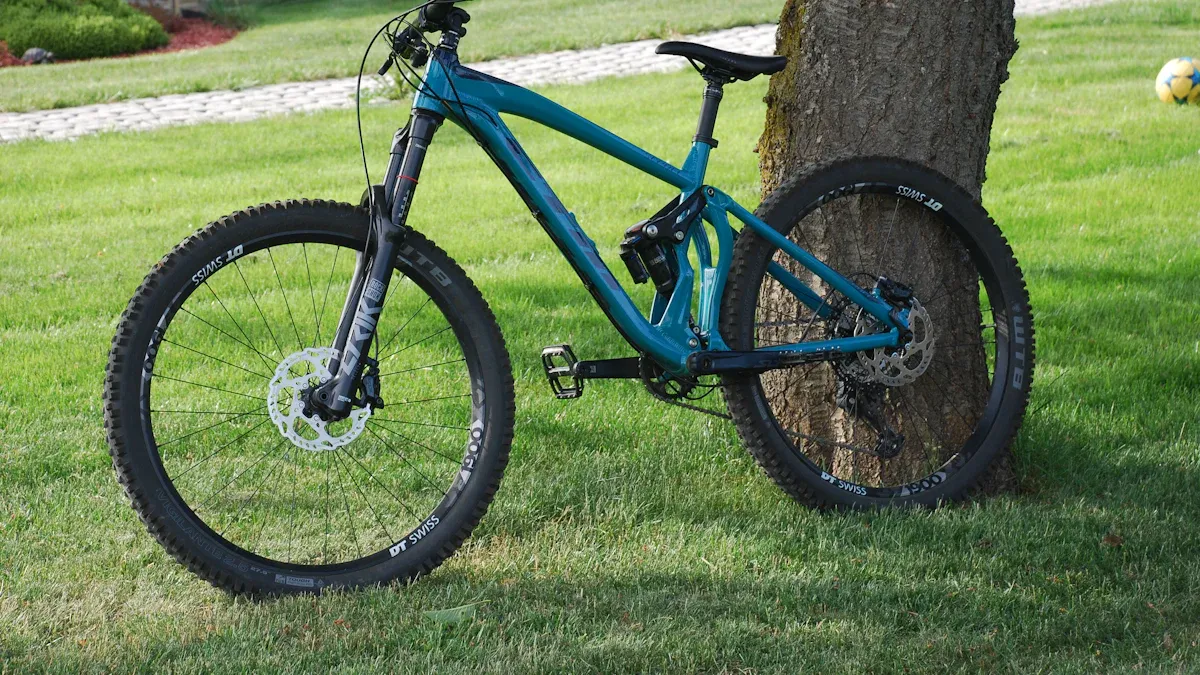
You use a full suspension bike frame for comfort and control on bumpy trails. This frame has a front fork and a rear shock. They help absorb bumps, rocks, and shakes. The suspension keeps both wheels touching the ground. This helps you ride on tricky paths and makes the ride smoother. You feel less tired because the rear shock protects your body from hard hits. Full suspension bikes help you ride almost any trail with more confidence and a smoother ride.
Key Takeaways
A full suspension bike frame has front and back suspension. These help take in bumps and keep both wheels on the ground. This makes your ride feel smoother. The suspension fork and rear shock work together. They lower the impact, give you better control, and protect your body on rough trails. Full suspension bikes give you more grip, comfort, and confidence. They help you ride faster and handle tough paths safely. Full suspension bikes are heavier than hardtail bikes. They also need more care. But they give you better comfort and control on rough trails. Pick your bike based on the trails you ride. Think about your budget. Also, think about how much comfort and control you want when you ride.
Full Suspension Bike Frame Components

A full suspension bike frame uses several key parts to help you ride smoothly over rough ground. Each part works together to absorb bumps and keep you in control.
Suspension Fork
The suspension fork sits at the front of your bike. It connects the front wheel to the handlebars. This fork uses springs or air chambers to soak up big hits from rocks, roots, and potholes. When you ride over rough terrain, the fork compresses and rebounds, making your ride smoother. The front and rear suspension work as a team to keep both wheels on the ground. This helps you steer better and feel less tired after long rides.
Rear Shock
The rear shock is the heart of the rear suspension. It sits between the main frame and the rear triangle. Modern rear shocks come in air or coil types. Air shocks let you adjust the pressure for your weight and riding style. Coil shocks are heavier but handle heat better and give a steady feel. You can fine-tune many rear shocks with dials for rebound and compression. This lets you match the rear suspension to your favorite trails.
Component | Role in Suspension System |
|---|---|
Frame | Acts as the backbone of the bike, providing the central structure to which all parts are attached. It supports the linkage and mounting points for suspension components. |
Fork | Connects the front wheel to the stem and includes suspension elements (stanchions with coil or air springs) that absorb shocks from the front terrain, allowing smoother steering and impact absorption. |
Rear Shock | Separates the front and rear triangles of the frame and is attached to the frame’s linkage. It allows vertical movement of the rear axle to absorb shocks from rough terrain, using air or coil systems for damping. |
Frame Design
The frame design shapes how your full suspension bike frame feels and lasts. A stiff front triangle gives you sharp steering and control. The rear triangle flexes just enough to help the rear suspension absorb impacts. Designers use pivots, linkages, and bearings to connect these parts. Fewer pivots mean less weight and more stiffness, but enough movement for the suspension to work well. Most frames use aluminum or carbon, lasting 5-10 years with normal use.
Suspension Travel
Suspension travel is the distance the suspension can move up and down. Most full suspension bike frames offer 150-170mm of travel. More travel helps you ride faster and safer on steep, rocky trails. Less travel makes climbing easier and keeps the bike lighter. You should pick your travel based on the trails you ride and your style.

Tip: Match your suspension travel to your favorite trails for the best ride!
How a Full Suspension Bike Works
Impact Absorption
When you ride over rough terrain, your full suspension bike frame works hard to keep you comfortable. The suspension at the front and rear absorbs bumps, rocks, and roots. This system uses springs and shocks to cushion every impact. You feel less jarring in your arms and legs because the suspension compresses and rebounds with each hit. The frame design allows each wheel to move up and down on its own. This movement keeps both wheels in contact with the ground, even when the trail gets uneven.
The suspension lets the wheels move independently, so you do not lose traction on rocky or root-filled paths.
Springs and shocks at the front and rear help absorb impacts, which protects your bike and your body.
The control arms and linkages in the frame manage the forces from the wheels, keeping the bike stable and balanced.
Suspension travel plays a big role here. More travel means the suspension can move farther, which helps you handle bigger drops and rougher terrain. You get a smoother ride and better ride quality, especially on technical trails.
Tip: If you want to ride fast and stay safe on rocky trails, choose a full suspension bike frame with enough travel for your favorite terrain.
Traction and Control
A full suspension bike frame gives you better handling and control on all types of terrain. The suspension keeps your tires pressed against the ground, even when you hit bumps or loose dirt. This constant contact means you get more grip, which helps you steer and brake with confidence.
The suspension absorbs shocks and prevents your wheels from bouncing off the ground.
Better traction leads to improved handling, so you can take sharp turns and steep descents without slipping.
The suspension system reduces vibrations that can make steering harder, giving you more precise control.
Improved control and comfort come from the way the suspension balances your weight and absorbs impacts. You can ride faster and tackle technical sections with less risk of losing balance. The suspension also helps you brake more safely, reducing the chance of skidding or crashing. When you ride a full suspension bike, you feel like you have an invisible hand guiding you over every obstacle.
Comfort and Confidence
You notice a big difference in comfort when you ride a full suspension bike frame. The suspension smooths out rough terrain, so you feel less tired and sore after long rides. The rear shock and front fork work together to absorb bumps, which protects your joints and muscles.
The suspension increases stability, making technical trails easier to handle.
You can ride over rocks, roots, and drops without feeling every hit.
The frame design gives you more room for error, so you can try new lines and features with less worry.
Full suspension bikes inspire confidence. You know the bike will handle tough terrain and keep you in control. This confidence lets you push your limits and enjoy the ride more. The improved ride quality and stability mean you can focus on the trail ahead, not on avoiding every bump. Many riders find that a full suspension bike frame helps them ride longer and have more fun, even on the most challenging terrain.
Full Suspension Mountain Bike vs. Hardtail

Key Differences
When you compare a full-suspension mountain bike to a hardtail, you notice several important differences:
A hardtail has a solid rear frame and only uses front suspension. This design makes the bike lighter and simpler, with fewer moving parts.
A full-suspension mountain bike uses both front and rear suspension. The rear shock and pivots allow the back wheel to move up and down, which helps absorb bumps and impacts.
The extra suspension on a full-suspension mountain bike adds weight and complexity, but it gives you more comfort and control on rough terrain.
Hardtails offer better pedaling efficiency because the rigid rear frame transfers your power directly to the ground.
Full-suspension mountain bikes provide a smoother ride, especially when you navigate technical trails or ride on challenging off-road trails.
Performance
Performance changes a lot depending on the type of bike you choose. A full-suspension mountain bike shines when you ride on rocky, root-filled, or steep terrain. The suspension keeps your wheels in contact with the ground, giving you better control and traction. You feel more confident when you ride fast or tackle tricky sections. This type of bike helps you handle mountain biking adventures where comfort and control matter most.
Hardtail bikes work best on smoother terrain like dirt roads or flow trails. You get more speed and efficiency because the bike is lighter and stiffer. If you want to climb hills quickly or race on cross-country courses, a hardtail might suit you better. However, a full-suspension mountain bike lets you push your limits on rougher terrain and gives you the confidence to try new lines.
Aspect | Full Suspension Mountain Bike | Hardtail Bike |
|---|---|---|
Weight | Heavier | Lighter |
Complexity | More complex (more moving parts) | Simpler (fewer moving parts) |
Control | Superior on rough terrain | Good on smooth terrain |
Comfort | High, absorbs bumps | Lower, more trail feedback |
Efficiency | Slightly less on smooth terrain | Higher on climbs and flat sections |
Maintenance and Cost
You need to think about maintenance and cost before choosing your bike. A full-suspension mountain bike has more parts that need care, like rear shocks, pivots, and bearings. You may spend more time cleaning and checking these parts, especially if you ride in muddy or wet conditions. Repairs and servicing can cost more, and sometimes you need a professional to help with complex parts.
Hardtail bikes are easier and cheaper to maintain. With fewer moving parts, you spend less time and money on repairs. Most riders can handle basic maintenance at home. If you want a bike that is simple to care for and costs less, a hardtail is a good choice. However, if you value comfort and control on rough terrain, a full-suspension mountain bike is worth the extra effort.
Tip: Choose a full-suspension mountain bike if you love mountain biking on rough terrain and want the best control. Pick a hardtail if you prefer lighter bikes, lower costs, and easier maintenance.
Pros and Cons of Full Suspension Bike
Benefits
You feel comfortable right away on a full suspension bike. The suspension at the front and back absorbs bumps and rocks. This helps your body stay fresh on long rides. You do not get as tired because the shocks soften every hit.
The suspension system softens impacts and lowers body strain.
You get better grip since the tires stay on the ground.
Suspension makes the bike stable and easier to control.
The rear suspension turns rough rides into smooth ones, protecting your body.
You feel braver on tricky trails and can go faster and safer.
Note: Full suspension bikes help you save energy and protect your joints and muscles. They are great for off-road riding and better performance.
Drawbacks
Full suspension bikes have some downsides you should think about. The extra suspension parts make the bike heavier and more complicated. This can change how the bike feels on smooth trails.
Full suspension bikes weigh more than hardtails and can be slower.
The longer frame and slacker angles make sharp turns harder.
Suspension uses some pedaling power, so you lose speed on flat ground.
The extra weight and parts need regular checks to keep working well.
These bikes cost more because of the special suspension parts.
Tip: If you want better performance on rough trails, pick a full suspension bike. If you want a lighter bike and easy care, a hardtail may be better for you.
You have learned that a full suspension bike frame uses suspension at the front and back. This helps make your ride smoother and gives you more control. It also makes bumpy trails feel easier. When picking between a full suspension and a hardtail, think about how much money you want to spend, where you will ride, and how you like to ride.
Factor | Full Suspension Bike Frame | Hardtail Bike |
|---|---|---|
Comfort | High, absorbs bumps | Lower, more feedback |
Maintenance | More complex | Easier, less costly |
Weight | Heavier | Lighter |
Decide what is most important to you. Do you want comfort, speed, or something simple? If you are not sure about suspension or want to make your ride better, look for more information or ask someone for help!
FAQ
What is the main benefit of a full suspension bike frame?
You get a smoother ride. The suspension absorbs bumps and rough spots. This helps you stay comfortable and in control on rocky or uneven trails.
How often should you service your suspension?
You should check your suspension every few months. Clean and inspect it after muddy rides. Most riders service the fork and rear shock once or twice a year.
Can you use a full suspension bike for city riding?
Yes, you can ride a full suspension bike in the city. The suspension makes curbs and potholes easier to handle. The bike may feel heavier than a road bike.
Is a full suspension bike good for beginners?
A full suspension bike helps beginners feel safe on rough trails. You get more comfort and control. You may find it easier to learn mountain biking skills.
How do you choose the right suspension travel?
Tip: Pick less travel (100-130mm) for smoother trails and more travel (150mm or more) for steep, rocky paths. Match the travel to your favorite type of riding.
See Also
Choosing Between Hardtail And Full Suspension Mountain Bikes
Key Differences Between Fat Bike And Mountain Bike Frames
Understanding The Technology Behind Mountain Bike Frame Flexibility
